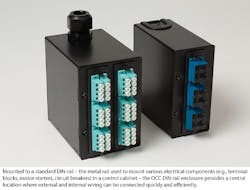By MICHAEL NEWMAN, Vice President, Optical Cable Corporation (OCC) -- The recent Santa Barbara, CA oil spill is yet another example of the need to monitor and control pipelines to prevent breaches that could endanger life and property for hundreds of miles overland and along coastlines. According to the Los Angeles News Group (June 10, 2015), the spill of more than 100,000 gallons of oil resulted from the failure of monitoring equipment to detect leaks in a corroded pipeline and to automatically shut off valves supplying the oil.
To protect infrastructures against such disasters, promote worker safety and facilitate automated functions ranging from drilling to wellhead operation and transport pipelines, oil and gas operators are increasingly turning to fiber-optic cable suppliers for “end-to-end” communications and control solutions. Many such solutions include ruggedized cable and connectors that ensure survival of fiber-based DCS/PLC automation/control architectures for onshore and offshore oil and gas operations, even in the harshest environments.
Integrating the DIN rail enclosure
As fiber-optic cable emerges as the medium of choice in many industrial arenas, the DIN rail enclosure plays an increasingly important role. Mounted to a standard DIN rail – the metal rail used to mount various electrical components (e.g., terminal blocks, motor starters, circuit breakers) in a control cabinet - a DIN rail enclosure provides a central location where external and internal wiring can be connected quickly and efficiently.
“Selecting the right fiber cable and connectors often requires a consultative process between customer and supplier,” explains Hoyle. “In our case, business development specialists like me will consult with an engineer, project manager or application specialist within the customer’s team. We’ll usually talk through the application and surrounding requirements. The next step is to provide a quote for the application, and review it step by step with the customer. In some cases we may provide the customer with a prototype or sample for testing processes. But whatever the solution, it is vital to ensure that it is end-to-end.”
For information contact: Optical Cable Corporation, 5290 Concourse Drive, Roanoke, Virginia, 24019; Phone: (800) 622-7711, Canada (800) 443-5262; FAX: 540-265-0724; Email: [email protected]; Visit the web site www.occfiber.com.



